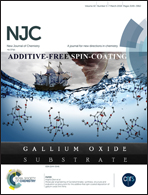Controllable ZnO architectures with the assistance of ethanolamine and their application for removing divalent heavy metals (Cu, Pb, Ni) from water†
Abstract
Controllable ZnO architectures were synthesized via a facile hydrothermal or solvothermal method with the help of ethanolamine, and without any addition of templates. It was found that the molar ratio between Zn(OAc)2 and NaOH, and the polarity of the solvent have a great impact on the formation of flowerlike, rodlike, and spherical ZnO architectures. The as-prepared ZnO may be used to remove divalent heavy metals (Cu2+, Ni2+, and Pb2+) from aqueous solution, and the concentration of heavy metals was monitored by an atomic adsorption spectrometer. The adsorption kinetics were well fitted to a pseudo-second order model, even if the structures of ZnO were different from each other. The equilibrium adsorption data for Cu2+, Ni2+, and Pb2+ were consistent with the Langmuir, Freundlich, and Langmuir isotherms, respectively. It should be mentioned that the adsorption capacity of ZnO products for removing various divalent heavy metals decreased as follows: Pb2+ > Cu2+ > Ni2+, and the order of adsorption capacity of ZnO with different morphologies can be calculated to be spherical ZnO > rodlike ZnO > flowerlike ZnO > commercial ZnO for the given heavy metal ions.



 Please wait while we load your content...
Please wait while we load your content...